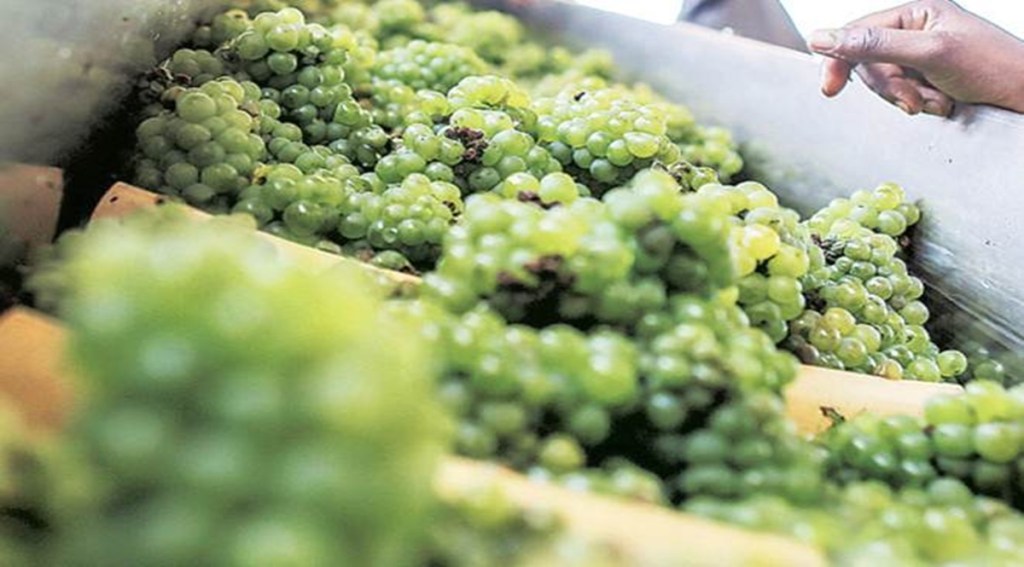Bhushan Rikame had earmarked his two-acre grape-growing plot for exports to the European Union. But on Saturday, the 31-year-old farmer had to sell his entire crop in a local mandi in Ahmedabad as unseasonal rains caused cracking of the fruit. “The grapes were to be sold at Rs 80 per kg for the European market. But I had to sell at Rs 10-12 per kg at the mandi, and ended up losing Rs 250,000 per acre as the actual cost of production was Rs 300,000 per acre,” he said.
It’s been a double whammy for grape farmers in Nashik, one of the largest grape growing belts in the country. The Russian invasion of Ukraine has made exports uncertain and unseasonal rains have increased domestic availability of grapes, forcing farmers to sell their produce at throwaway prices.
Suresh Kalamkar, another grape farmer points out that at least 30 bundles of newspapers are required to cover the fruit for an acre before harvesting the crop. “One kg of paper costs Rs 30 and we have pay Rs 3,000 per acre to cover the fruit. A similar amount is required to be paid to labourers for removal of the paper sheets and harvesting the fruit,” he says. Kalamkar was hoping to get Rs 70- 80 per kg for his fruit. But since the European Union rejects cracking in grapes, his hopes of good exports have been dashed.
“Now I can only get Rs 10-15 per kg for this, he said, showing the cracked fruit. Kalamkar has also begun diversifying from grapes to other short-term vegetables that can get him better prices. Due to the recent unseasonal rains last week, of the total grape damage on 869.20 hectare in Nashik district, grapes on 780 hectares were damaged in Niphad taluka alone.
Pruning of the grapes began from September 15 and ever since there have been rains almost every month, affecting the flowering initially. When the sugar content is high, then cracking began. “The life of a farmer is tough,” Kalamkar said, adding farmers have to keep awake at nights to ensure that the vineyards are irrigated as there is load shedding during the day.
Grape growers have been facing losses for the last three years — Covid impacted sales for two years and cracking of grapes last year, said Ravindra Nimse, president of the Nashik branch of Maharashtra State Grape Growers Association.
Kailash Bhosale, vice-chairman of Maharashtra Grape Growers’ Association, said farmers have exported 15,000 tonne of grapes to Russia and 1,000 tonne to Ukraine. The usual exports to these countries are 24,000 tonne and 2,300 tonne, respectively. But exports to both countries have now come to a grinding halt.
The loss of exports to Europe is particularly worrying as of the 129,000 tonnes grapes exported in 2020-21 (December-April), 96,000 tonne were exported to European countries alone. The situation is so bad now that at least a third of grape growers are wanting to shift from grape cultivation and shift to other crops. This is a 365-day crop and requires to be looked after throughout the year, Bhosale says.
Significantly, this season, grape growers had decided to fix prices of grapes to be sold to traders in anticipation of a good crop. Jagannath Khapre, president, Grape Exporters Association (GEA) points out that while official export figures are available for Europe and UK, there is no official record of exports to Bangladesh, Sri Lanka, China or Russia. Figures that are shared are usually taken from exporters and these may not be accurate, he says. Khapre however agrees that exports this year have slowed not only to Russia but also European countries.
As on March 1, 2022, only 38,481 tonne of grapes have been exported to the European Union as against 106,809 tonnes in the same time last year, according to figures on the Apeda website. Other factors hampering exports include a doubling in freight costs o $8000 per container.
Vilas Shinde, CMD, Sahayadri Farms, however has a different take on the issue. According to him, this situation occurs almost every season in March when the arrivals peak causing a glut in the market, forcing farmers to sell at distressed prices. “Russia and Ukraine are hardly major buyers of grapes from India and barely import 1,000-1,500-odd containers from India. Selling to wineries is not a feasible solution, Table grapes either need to be converted to raisins and a strong brand campaigning for the domestic marketing is required. This is a perishable crop and therefore farmers are forced to sell at distress rates. If the domestic market itself becomes strong, the export market automatically becomes strong. Improving the domestic market is the actual solution”, he said.
Shinde said if grapes are stored well, they can last for four months. Next year onwards, he plans to increase cold storage capacity and increase the sale price for the domestic market. Sahayadri has taken an initiative to improve cold storage to 22,000 tonne at the farmer producer company level and bring in new varieties that last longer, he said.

